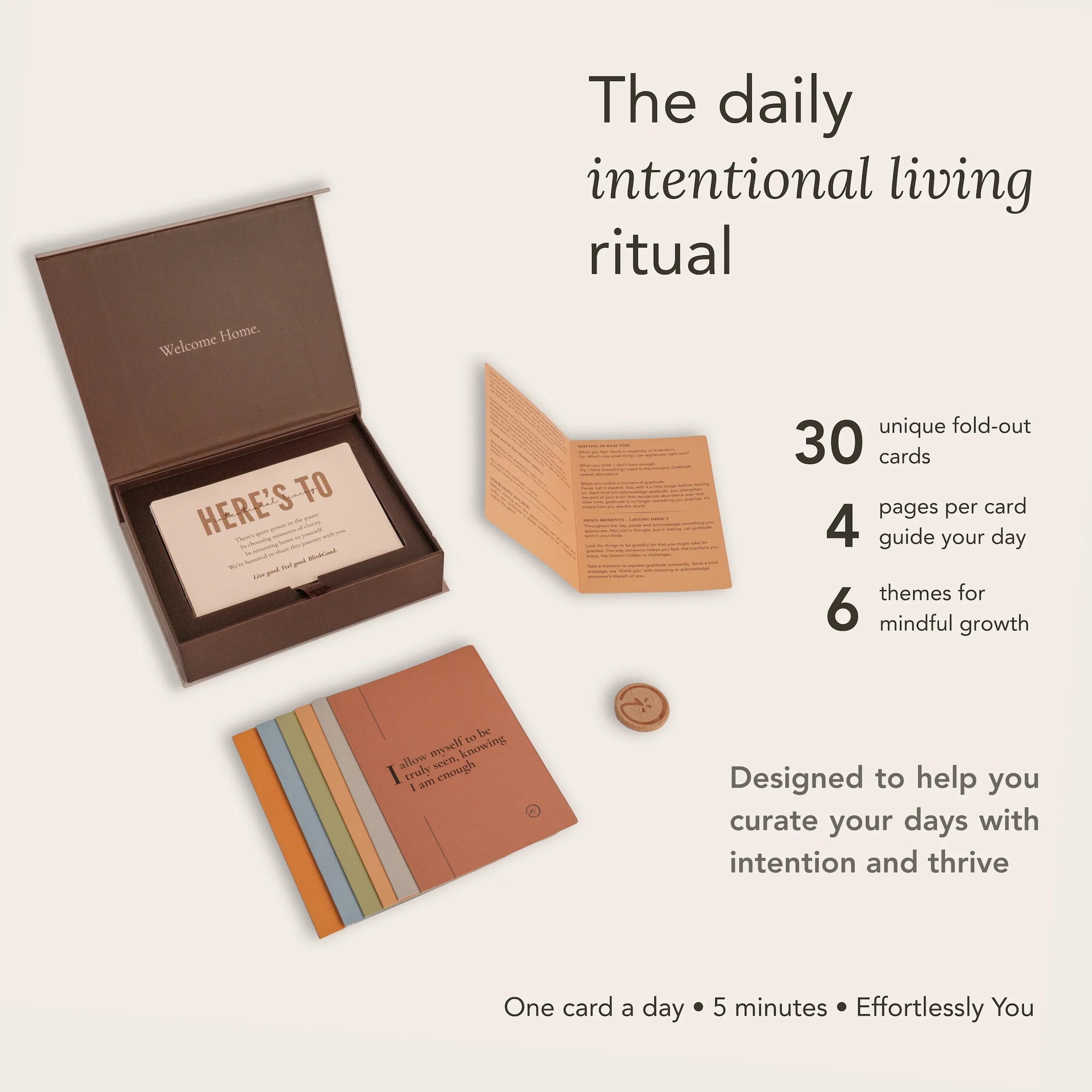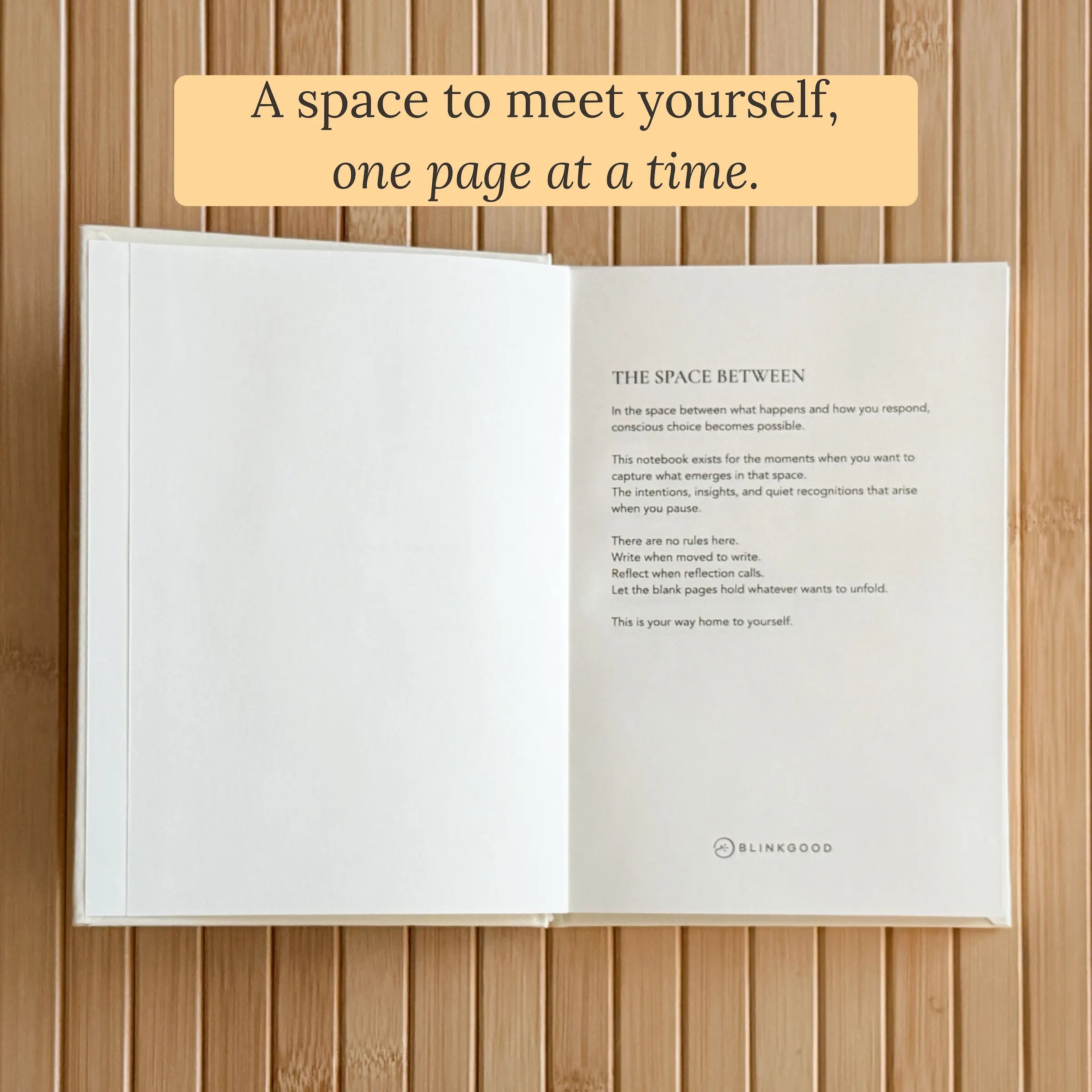Functional Mindfulness, The BlinkGood Way: An Evolution in Present-Moment Practice
Our approach aims to dissolve the line between “practice” and “life,” making mindfulness accessible, screen-free, and imperfectly us — so it becomes a natural way of living instead of something you need to squeeze into your day.
An Evolution in Everyday Presence
Mindfulness has always evolved. From its contemplative beginnings in monasteries to its integration into psychology and modern wellness, the practice has continually adapted to new contexts.
Functional Mindfulness represents this next chapter. It doesn’t replace traditional practices — it extends them into the places where life actually happens: in conversations, at home, at work, and in the small transitions that often go unnoticed.
This evolution honors contemplative traditions while addressing the practical challenges many face in sustaining meaningful practice within modern life's complexity.
It's BlinkGood's approach to intentional living that mindfulness works with you in day to day living instead of being a task that needs to be carved out.
The goal is to dissolve the boundary between mindfulness and the rest of your life and create a way of being where awareness becomes so integrated into how you move through the world. You're not trying to be mindful. You're simply living from a place of inherent presence where you can live an intentional life in whatever way you choose it to be.
The mindfulness paradox BlinkGood is solving: presence alone feels incomplete, but growth without presence feels unsustainable. Functional Mindfulness bridges that gap — meeting you in real life with practices that are both grounded and growth-oriented. Not rituals you have to carve out, but moments you can actually live.
Practical Mindfulness Techniques
Designed for modern life and people seeking mindfulness.
Quality Over Quantity
Focused on the quality of your mindfulness practice, not the duration. A consistent one minute moment of true presence can be more powerful than occasional random 30 minutes that tend to fall off as a practice.
Science-Based Mindfulness
Built using inspiration from neuroscience research, habit formation psychology, and behavioral principles that may create lasting change through small, consistent moments of presence so that mindfulness works with you, not against you and doesn't overwhelm you.
Imperfect Is Welcome
Presence counts even if it’s brief, messy, or interrupted.
This is mindfulness softened, reimagined through the lens of intentional living: not rigid, not intimidating — simply a way of coming home to yourself, again and again.
The Implementation Challenge
How often have you searched for "mindfulness techniques that actually work" only to find meditation apps that require 20+ minutes you don't have? Despite widespread acceptance of mindfulness principles and significant investment in digital wellness platforms, sustained practice remains challenging for many.
If mindfulness has felt elusive, what if you're not failing your practice? Is it that your practice may be failing to honor your unique situation?
Common Implementation Barriers:
- Time Architecture: Finding 20-30 minutes in your already busy schedule for meditation
- Environmental Assumptions: Struggling with "perfect" focus during meditation sessions or the 'monkey mind'
- Integration Gaps: Feeling disconnected between practice and real-world stress
- Abstract Progress: Feeling frustrated with unclear guidance and difficult-to-measure results
Rather than asking you to add another practice to your overwhelmed schedule, Functional Mindfulness helps recognize moments you're already living into opportunities to feel more like yourself. It's presence that works within your real circumstances - the messy, noisy, beautifully 'imperfect' life you're actually living.
The BlinkGood Approach
Functional Mindfulness integrates contemplative awareness with intentional living principles. It's mindfulness as a foundation for intentional living, not as an escape from it. Rather than requiring removal from daily activities, it reveals opportunities for extraordinary presence within ordinary moments that transforms routine transitions into gateways for conscious choice.
Core Design Principles
Quality Over Quantity Focused on the quality of your mindfulness practice, not the duration.
Integration Over Addition Instead of adding mindfulness to an already full life, Functional Mindfulness illuminates the contemplative potential already present in existing moments: the pause before responding to a message, the breath between meetings, the moment of choice before reacting to unexpected news. We're not asking you to become a meditator (though that has immense advantages). We're inviting you to become someone who lives mindfully. Instead of adding mindfulness to an already full life, Functional Mindfulness dissolves the artificial boundary between 'mindful moments' and 'regular life.' The goal is to live from a place where awareness has become your natural way of being. And this doesn't diminish the way you live or the goals you set for your life trajectory. The goal is to live intentionally in whatever way that you decide to.
Imperfect Mindfulness™ Embraces Imperfect Mindfulness™ where presence thrives in messy, real life. It eases the pressure for perfect practice — reminding us that even brief, interrupted, or imperfect awareness is still awareness. This is the practice.
Beautiful Simplicity Following principles of thoughtful design, practices emphasize elegant simplicity over complexity. Creating space for presence to emerge naturally rather than forcing it through technique. No special equipment, no extended time commitments, no perfect conditions required.
Functional Mindfulness Exercises for Everyday Life
Functional Mindfulness is designed for day to day lives - when you're too busy to meditate, emotionally overstimulated, feeling disconnected from yourself, tired of rigid wellness routines, or needing quick ways to calm. But the beauty is that it is designed not only for the tough moments. But for the easy ones too.
5 Ways to Practice Functional Mindfulness Today
We call these BlinkShifts™ – small portals back to presence for busy people seeking mindfulness without meditating.
- Before opening your laptop: Feel your feet on the ground for three seconds
- When overwhelmed: Silently name what you're feeling without trying to change it
- While brushing your teeth: Notice the temperature, texture, and sensation
- During difficult conversations: Place one hand on your chest before responding
- When you catch yourself spiraling: Take one conscious breath and ask: "What would feel most like me right now?"
An Invitation to Embodied Presence
Functional Mindfulness doesn't require becoming a different person or restructuring your entire life. Instead, it invites you to discover how contemplative awareness can enhance the relationships you already have, the work you already do, and the daily choices you already make.
This represents mindfulness as a way of being rather than a separate activity — presence as foundation for intentional living rather than escape from it.
The invitation is both simple and profound: What if your next moment of awareness—however brief, however imperfect — could be the beginning of a more conscious, authentic way of moving through the world?
Experience Functional Mindfulness™ in a Whole New Way
Our tactile, screen-free intentional living tool that turns everyday moments into mindful micro-practices.
Mindfulness Made Simple
- A first-of-its-kind mindfulness system based on The Blink Method
- Designed for practical mindfulness, not perfection. Integrates into your real life
- Screen-free alternative to mindfulness apps and meditation programs
- Six transformational mindfulness pathways to address every aspect of life
The Bottom Line
The goal isn't to carve out time for mindfulness. It's to dissolve the boundary between "being mindful" and "living your life."
Frequently Asked Questions About Functional Mindfulness
What are the best mindfulness techniques for beginners?
The most effective mindfulness techniques for beginners are micro-practices that integrate into existing routines through intentional living. Start with transition breathing between activities, mindful hand-washing, or placing attention on your feet while waiting in line. These practical mindfulness exercises require no special training and create immediate benefits using The Blink Method
How is Functional Mindfulness different from meditation?
Traditional meditation is often time-bound and structured. Functional Mindfulness is situational — short, integrated pauses woven into daily life. Meditation can be a great tool in your mindfulness journey.
- The Blink Method – Our four-step framework for practical mindfulness
- Imperfect Mindfulness – Presence without performance pressure
-
The Blink Effect – How tiny changes create lasting transformation
Begin your Journey




